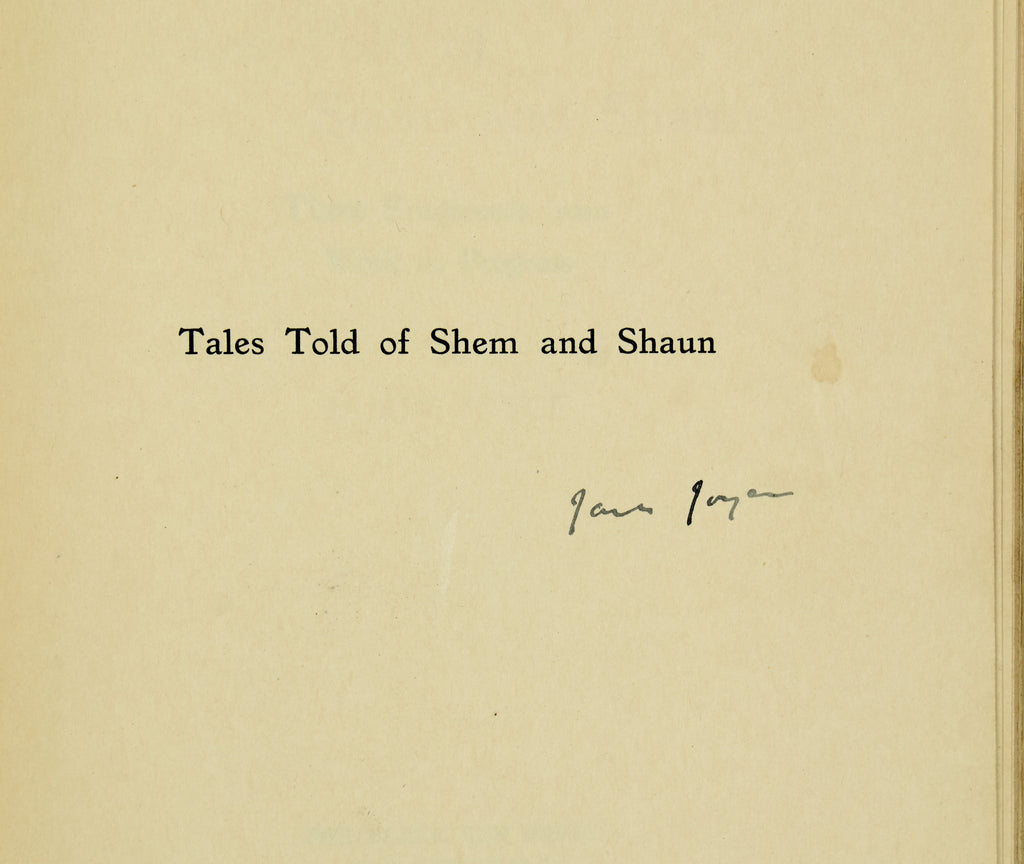Tales Told of Shem and Shaun. Three Fragments from Work in Progress.
JOYCE, James



Paris: The Black Sun Press. 1929.
First edition. Number 38 of 100 copies on Japanese Vellum signed by the author. 4to. 212x168mm. [8], XV, [1], 55, [3]. Original cream paper wrappers lettered in black and red to upper cover and spine and with 'black sun' motif on the lower cover. Original glassine wrapper. Slight chipping to head of spine and there are some tears to the glassine wrapper at the spine and to the front wrapper but overall in very good condition. Internally excellent with only very minor marking in a few places. Housed in the cardboard slipcase covered with green paper and edged in silver paper to which there is some slight marking and wear to the edges. Signed on the half title by James Joyce in black ink and illustrated with Constantin Brancusi's etching Symbole de Joyce, intended by the artist to capture Joyce's "sens du pousser" and described as "a portrait as abstract as the author's text". With a preface by C.K.Ogden who, in the same year as the publication of Shem and Shaun, arranged a recording of Joyce reading from Anna Livia Plurabelle, the first published section of Work in Progress.
In an interview of 1936, Joyce said "I haven't lived a normal life since 1922, when I began Work in Progress. It requires an enormous amount of concentration...Since 1922 my book has become more real to me than reality, and everything has led to it". "My book" is Finnegans Wake to which, during its seventeen year gestation, Joyce gave the name Work in Progress. In the late 1920s, Joyce published three sections of Work in Progress: Tales Told of Shem and Shaun is the second. Reviews concentrated on the Joyce's verbal brilliance while noting its limited appeal. To H.G.Wells, Work in Progress was "an extraordinary experiment" but also "a dead end". Joyce was undeterred. In 1937, two years before the publication of Finnegans Wake, Joyce said of "the few fragments which I have published" that they "have been enough to convince many critics that I have finally lost my mind....And perhaps it is madness to grind up words in order to extract their substance, or to graft them one onto another, to create crossbreeds and unknown variants, to open up unsuspected possibilities for these words, to marry sounds which were not usually joined together before, although they were meant for one another, to allow water to speak like water, birds to chirp in the words of birds, to liberate all sounds of rustling, breaking, arguing, shouting, cracking, whistling, creaking, gurgling - from their servile, contemptible role and to attach them to the feelers of expressions which grope for definitions of the undefined".
First edition. Number 38 of 100 copies on Japanese Vellum signed by the author. 4to. 212x168mm. [8], XV, [1], 55, [3]. Original cream paper wrappers lettered in black and red to upper cover and spine and with 'black sun' motif on the lower cover. Original glassine wrapper. Slight chipping to head of spine and there are some tears to the glassine wrapper at the spine and to the front wrapper but overall in very good condition. Internally excellent with only very minor marking in a few places. Housed in the cardboard slipcase covered with green paper and edged in silver paper to which there is some slight marking and wear to the edges. Signed on the half title by James Joyce in black ink and illustrated with Constantin Brancusi's etching Symbole de Joyce, intended by the artist to capture Joyce's "sens du pousser" and described as "a portrait as abstract as the author's text". With a preface by C.K.Ogden who, in the same year as the publication of Shem and Shaun, arranged a recording of Joyce reading from Anna Livia Plurabelle, the first published section of Work in Progress.
In an interview of 1936, Joyce said "I haven't lived a normal life since 1922, when I began Work in Progress. It requires an enormous amount of concentration...Since 1922 my book has become more real to me than reality, and everything has led to it". "My book" is Finnegans Wake to which, during its seventeen year gestation, Joyce gave the name Work in Progress. In the late 1920s, Joyce published three sections of Work in Progress: Tales Told of Shem and Shaun is the second. Reviews concentrated on the Joyce's verbal brilliance while noting its limited appeal. To H.G.Wells, Work in Progress was "an extraordinary experiment" but also "a dead end". Joyce was undeterred. In 1937, two years before the publication of Finnegans Wake, Joyce said of "the few fragments which I have published" that they "have been enough to convince many critics that I have finally lost my mind....And perhaps it is madness to grind up words in order to extract their substance, or to graft them one onto another, to create crossbreeds and unknown variants, to open up unsuspected possibilities for these words, to marry sounds which were not usually joined together before, although they were meant for one another, to allow water to speak like water, birds to chirp in the words of birds, to liberate all sounds of rustling, breaking, arguing, shouting, cracking, whistling, creaking, gurgling - from their servile, contemptible role and to attach them to the feelers of expressions which grope for definitions of the undefined".
